Welcome to part three of four of my Top Toys series! To read more about why I am doing this series, please check out Part One HERE. You can also check out part two HERE.
I am writing these posts to help parents pick good, quality toys for their infants, toddlers and preschoolers that can be used to help support speech and language development. As I share with you my personal top picks for toys for infants, toddlers and preschoolers, I will also be sharing the areas of speech and language that these toys can help support. However, as I noted in part one, it is important to know that for these toys to help support speech and language development you, as the parent or caregiver must help to facilitate that language. What I mean is this: You can’t just give a child a shape sorter and expect him to magically know and use the names of shapes and colors! You need to sit with your child and facilitate his learning. You need to use some strategies that I have mentioned before including:
Parallel Talk, Self Talk, & Descriptions
Expansions, Extensions, and Repetitions
Commenting and Asking Questions
If you are a fellow speech pathologist and work with infants, toddlers or preschoolers, you may also find this series of posts valuable for choosing therapy materials.
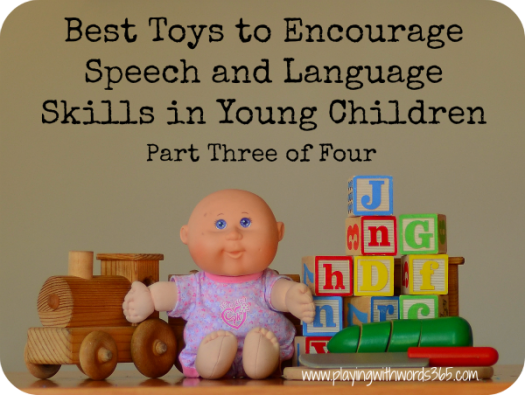
Here are my next five top picks for toys (in no particular order)
Kitchen set
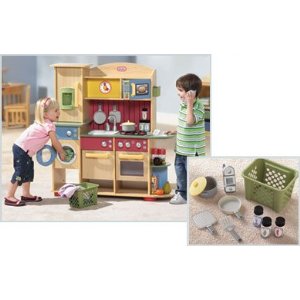 We got my daughter her play kitchen for Christmas the year she was two. Actually, Santa brought it for her. We got her the one pictured above but there are SO many different kitchen sets out there to choose from at very reasonable prices. I personally have an aversion to big plastic toys and prefer the wood kind, which is one reason we chose the Little Tikes Deluxe Wooden Kitchen and Laundry Center
We got my daughter her play kitchen for Christmas the year she was two. Actually, Santa brought it for her. We got her the one pictured above but there are SO many different kitchen sets out there to choose from at very reasonable prices. I personally have an aversion to big plastic toys and prefer the wood kind, which is one reason we chose the Little Tikes Deluxe Wooden Kitchen and Laundry Center above. A friend of ours got an amazing kitchen similar to ours at a second hand store! Pick yourself up some inexpensive fake foods and you will have an extensive amount of speech and language practice (Ikea, Target, Toys R Us all carry inexpensive sets, but I am also a bug fan of Melissa and Doug products). Let’s look at just some of the language concepts that a kitchen play set can help teach and support:
- Vocabulary/labels: You can target all the labels for the items in the kitchen as well as all food items and extras: Food, parts of the kitchen (stove, fridge, microwave, laundry, oven), kitchenware (plates, bowls, utensils, pots, pans), etc.
- Basic Concepts: You can basically work on ALL basic concepts while using some simple fake food and maybe some pots and pans too. Prepositions like in, out, on, off, through, next to; Size concepts like big, small, biggest, smallest, bigger, smaller; colors; counting skills; etc. You do this by placing the food or other kitchen utensils in different areas of the kitchen set and manipulating the objects. The possibilities are ENDLESS!
- Verbs: Again, the possibilities are endless here also. During play activities you can work on verbs like cook, eat, drink, put, take, give, etc.
- Following/Giving Directions: You can use the toy kitchen to work on following or giving directions. Ask the child to do a specific task (i.e. “Can you give me a cup of juice?” or “Can you put the orange in the refrigerator?”). You can also have the child practice giving directions during the play activity.
- Answering “wh†questions: You can ask your child an array of questions to work on her understanding of the target vocabulary. Where is the sandwich? Who has the fork? What color is this tomato?
- Social/pragmatic skills: A kitchen set is another great way to work on social skills. Eye contact, topic initiation, topic maintenance, topic closure, personal space, sharing, asking and answering questions, etc.
Doll house
 This is one toy that we actually do NOT own yet! I have been considering purchasing the Melissa & Doug Fold and Go Mini Dollhouse
This is one toy that we actually do NOT own yet! I have been considering purchasing the Melissa & Doug Fold and Go Mini Dollhouse pictured above because I LOVE how it closes up and keeps everything inside. However I have used doll houses in my therapy sessions with little ones for years because you can target SO many speech and language concepts and play skills. Let’s look at just some of the language concepts that a doll house can help teach and support:
- Vocabulary/labels: You can target all the labels for the items in the house as well as the family members/pets in them!
- Basic Concepts: You can basically work on ALL basic concepts using the doll house, furniture and dolls. Prepositions like in, out, on, off, through, next to; Size concepts like big, small, biggest, smallest, bigger, smaller; colors; counting skills; shapes (i.e. shapes of the windows, doors, furniture, etc.)
- Verbs: Again, the possibilities are endless here! While manipulating the dolls they can eat, drink, sit, stand, run, walk, skip, go up, come down, sleep, etc.
- Part/Whole relationships: A doll house is fantastic for part whole relationships. You can use the whole house and talk about the parts in MANY different ways (i.e. walls, roof, floor, windows, rooms, etc) or you can pick just one room and talk about its parts (kitchen, for example). You can also pick out different furniture and talk about the parts and the whole (i.e. a table has four legs and a top, a chair has four legs, a seat, and a back).
- Following/Giving Directions: Take turns giving each other directions on what the dolls should do! Incorporate the concepts and vocabulary you are targeting. i.e. “Put the doll in the big bed” or “I think the doll is hungry. Put the doll in the chair for dinner time.”
- Answering “wh†questions: You can ask your child an array of questions to work on her understanding of the target vocabulary. Who is this? Where is the mommy doll? Why is the daddy sleeping?
- Social/pragmatic skills: I always use doll houses in my social/pragmatic language groups. So many things can be targeted including eye contact, topic initiation, topic maintenance, topic closure, personal space, sharing, asking and answering questions, etc.
Doctor/Vet set
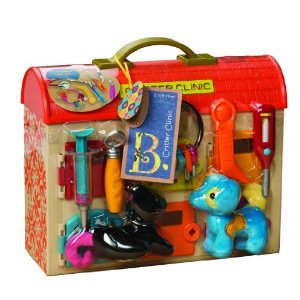 My daughter has to go to the doctor quite a bit for her Juvenile Arthritis, and so it didn’t come as a hugs surprise when she stared playing doctor! When she started giving us “boo boo shots” she would use her play spoons and knives as the syringe. THEN, for her birthday, my friend got her the B. Critter Clinic pictured above. It comes with all the standard doctor/Vet gear and she immediately started using them to play doctor! Doctor and Vet kits can really open up imaginations and target some diverse vocabulary. Let’s look at just some of the language concepts that a doctor or vet set can hep teach and support:
My daughter has to go to the doctor quite a bit for her Juvenile Arthritis, and so it didn’t come as a hugs surprise when she stared playing doctor! When she started giving us “boo boo shots” she would use her play spoons and knives as the syringe. THEN, for her birthday, my friend got her the B. Critter Clinic pictured above. It comes with all the standard doctor/Vet gear and she immediately started using them to play doctor! Doctor and Vet kits can really open up imaginations and target some diverse vocabulary. Let’s look at just some of the language concepts that a doctor or vet set can hep teach and support:
- Vocabulary/labels: You can target all the labels for the items in the set as well as items in a vet or doctor office that you can create in your home. Stethoscope, syringe, tweezers, band aids, sling, thermometer, scrubs, doctor coat, bed, etc.
- Basic Concepts: Work on prepositional concepts like on, off, up, down, etc. (stethoscope ON the heart/chest);
- Feelings: You can target different feelings like sick and healthy and talk about how you feel when you are sick vs. how you feel when you are healthy. For example, when we are sick we might feel tired, nauseous, or grumpy.
- Answering “wh†questions: You can ask your child an array of questions to work on her understanding of the target vocabulary. How does the kitty feel? Where is the syringe? What do we do with a stethoscope? How do shots feel? Etc.
- Social/pragmatic skills: When playing doctor/vet with your child work on appropriate social skills such as eye contact, topic initiation, topic maintenance, topic closure, personal space, sharing, asking and answering questions, etc.
Dress up clothes
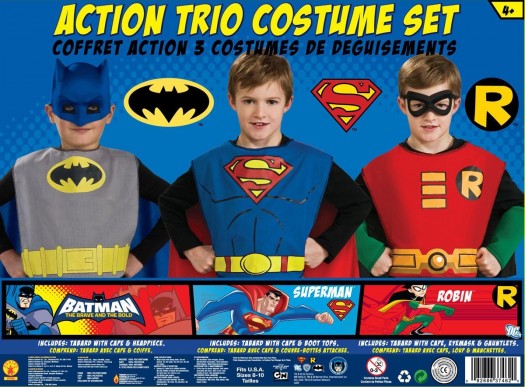
I think of dress up clothes, in relation to speech and language skills, to be a great supplemental item to help support another learning activity or lesson. For example, if you have a child who is really into superheros, you can read a book about a superhero and then use the dress up clothes to act out the book. Have a little girl who is obsessed with princesses (like mine?) You can do the same thing: read a book and then do some play activities to encourage acting out the book and using pretend play. Let’s look at just some of the language concepts that dress up clothes can hep teach and support:
- Vocabulary/labels: You can target all the labels for the items in the kitchen as well as all food items and extras: Food, parts of the kitchen (stove, fridge, microwave, laundry, oven), kitchenware (plates, bowls, utensils, pots, pans), etc.
- Basic Concepts: I think a fun way to work on concepts is to dress up like a superhero and then pretend to be one “flying” around the house/outside. Prepositions like in, out, on, off, through, next to, between, up, down, high low, under, etc.
- Verbs:Â Dress up and target verbs like run, walk, crawl, skip, jump, climb, fly, etc.
- Following/Giving Directions: Naturally weave in some directions while you dress up with your child targeting the vocabulary, concepts, and verbs mentioned above. “Let’s pretend to FLY like Superman!” or “Let’s CLIMB like Spiderman!”
- Answering “wh†questions: You can ask your child an array of questions to work on his understanding of the target vocabulary. Where are you going? Where should we climb? What color is Spiderman’s suit? What color is Belle’s dress?
- Social/pragmatic skills: Playing dress up is a PERFECT time to work on social/ pragmatic and play skills! Eye contact, topic initiation, topic maintenance, topic closure, personal space, sharing, asking and answering questions, etc.
Sand/Water Play Table and Toys
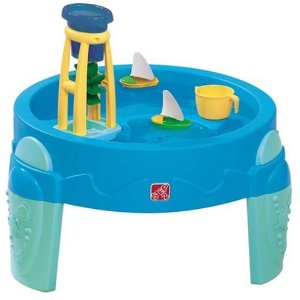 Sand and water play is SO FUN! You obviously do not need to buy a water table to participate in this kind of play, but we have a sand and water table similar to the Step2 WaterWheel Activity Play Table
Sand and water play is SO FUN! You obviously do not need to buy a water table to participate in this kind of play, but we have a sand and water table similar to the Step2 WaterWheel Activity Play Table pictured above and we enjoy it. You can do sand play at your local park or just fill up a large tote with sand. You can do the same with water play! Just grab some plastic cups and spoons and fill up the sink (and place a large towel on the floor, HA!). Let’s look at just some of the language concepts that sand and/or water toys can hep teach and support:
- Vocabulary/labels: You can target water/sand play words like water, sand, cups, shovel, rake, etc.
- Basic Concepts: You can basically work on ALL basic concepts while using sand and water. While building in sand or playing with water, you can target prepositions like in, out, on, off, through, next to; Size concepts like big, small, biggest, smallest, bigger, smaller; colors; counting skills; etc.
- Verbs: Target verbs like build, move, put, take, rake, push, pull, make, etc.
- Answering “wh†questions: You can ask your child an array of questions to work on her understanding of the target vocabulary. Where is the big cup? How did you make that tower of sand? What color is that cup?
- Social/pragmatic skills: While playing with your child work on appropriate social skills: eye contact, topic initiation, topic maintenance, topic closure, personal space, sharing, asking and answering questions, etc.
There are my next 5 recommendations! Check out the links below for my other 15 picks!
Best Toys for Speech & Language Development: Part One
Best Toys for Speech & Language Development: Part Two
Best Toys for Speech & Language Development: Part Four
Cheers!
WOW. Thank you so much for posting this! I saw it on pinterest (and repinned). Off to find parts 1 and 2 to read.
You are welcome! And thanks so much for repining 🙂
Thanks a lot for this. I’ve just gone to fish out all. The toys lying around and I’m putting them to their appropriate uses, and discarding the talking ones as I’ve found my don tends to echo them all without until recently, much words of his.
Thanks again.